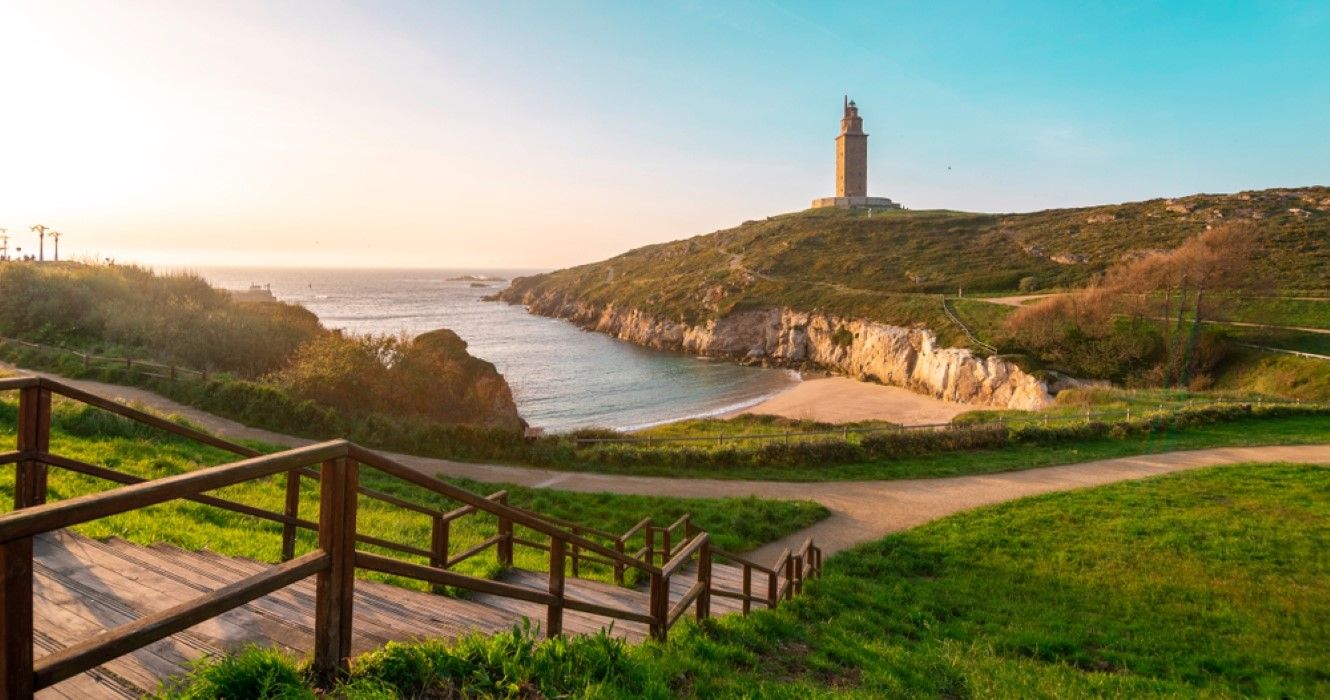Quick Links
Since the late 1st century A.D., the Tower of Hercules has stood as a beacon and landmark at the entrance to La Corua harbor in northwest Spain. It is the only functioning Roman lighthouse from classical times and the best-preserved example of its kind. According to legend, it is also the final resting place of one of Hercules' greatest conquests.
This Atlantic peninsula combines natural beauty with a rich cultural heritage. The tower's massive size and prime location by the untamed sea make this location exceptionally desirable. Additionally, Corunna is close to where the lighthouse stands, with the monument only half an hour away from the city's heart.
A Look Back At The Tower's Past
Many questions remain unanswered concerning the Tower of Hércules, including its birth and basic form. However, one can confidently assert that Romans were the original builders of the lighthouse due to the information provided and corroborated by scientific research (archaeological digs, study of the architectural walls and the construction methods, and the paperwork preserved).
The harbor of A Corua became strategically significant to Roman trade routes between the Mediterranean and North Atlantic coasts with the Roman conquest of Western Europe (Spain, Gaul, and Britain). Despite its location on a dangerous stretch of beach, the port became a central hub for ships making the journey to or from Britain. To aid the passage of commercial and military vessels, the Romans built a massive lighthouse now known as the Tower of Hércules in the city they named Brigantium.
The building, which dates back to the second century and was formerly known as the "Farum Brigantium" or "Brigantia Lighthouse," might easily pass for a product of the twentieth century. As its base, a 57-meter-tall rock supports the tower. The remaining 55 meters contain the original Roman masonry (at 34 meters) and the restoration (at 21 meters) led by architect Eustaquio Giannini in the 18th century.
The Tower And All The Legends That Encircle It
Countless legends have spread over the centuries about how the lighthouse started. Legend has it that Hercules fought the enormous ruler Geryon for three days and nights straight before finally killing him in a narrative that combines aspects from both Celtic and Greco-Roman mythologies. Hercules buried Geryon's head among his weapons in a symbolic act common to the Celts and then had a city constructed there. The coat of arms of A Corua has a lighthouse perched above a skull and crossbones, signifying the buried head of Hercules' killed enemy.
According to another myth preserved in the "Book of Invasions" (Lebor Gabála Érenn), compiled by the Irish in the 11th century, King Breogán, the progenitor of the Galician Celtic people, built a tower so tall that his sons could see the distant green shore from the top. The sight of the verdant land enticed them to set sail for Ireland. The tradition claims that Breogán's offspring settled permanently in Ireland and became the modern Irish's Celtic forebears. By the bell tower stands a gigantic statue of Breogán.
Several routes for medieval maritime crusaders to the Holy Land included a halt at the lighthouse as part of the journey. Typically, this is where the crusader boats would dock so that their passengers could begin the long walk to Santiago de Compostela and the shrine dedicated to Saint James the Greater. The works De expugnatione Lyxbonensi and De itinere Frisunum contributed to the perpetuation of the myth that Julius Caesar had constructed the lighthouse, likely due to a misunderstanding of the ancient inscription.
The Tower Through The Centuries To The Present Day
The tower's use as a lighthouse ended during the Middle Ages. From then on, it also served as a defensive castle and, beginning in the 13th century, a quarry that supplied building materials for the nearby Crunia settlement.
Work on the Tower of Hércules' final restoration project began in 1788. After its completion in 1790, the tower took on its contemporary look, with only minor alterations.
In 1927, the lighthouse got its first electricity. The tower had modest internal renovation beginning in the 19th century and continuing to the end of the 20th century. The tower's interior was renovated in 1849 to contain the first School of Lighthouse Keepers in Spain and operated until 1854.
Decorative wallpaper adorned the tower's interior from 1858 to 1906. In 1909, a stone handrail replaced the wooden railing on the staircase, and in 1927, the lighthouse received electricity. At the base of the tower's platform, various keepers' quarters were constructed between 1861 and 1956.
- What to know before a visit: Visitors can visit the basement, which contains the original roman lantern of the lighthouse, and then ascend the 234 steps to the lighthouse's upper balcony. If high winds are present, it will be closed.
- Address: Av. Navarra, s/n, 15002 A Coruña, Spain. Open every day from 10 AM to 8 PM.
- Where to stay in the area: TH Suites by Como en Casa offers modern apartments with beautiful views of the Tower of Hercules. Book a room here.

